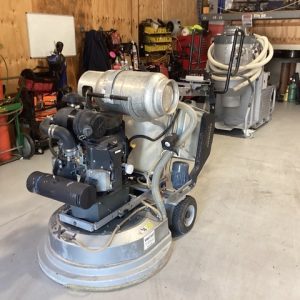Submit Quote or Call for Price - (949) 922-5728
Shot blasters propel small round steel media, like small metal BBs, at the floor’s surface, hitting the floor before rebounding upwards. They are ideal for removing existing coatings while simultaneously preparing the surface for a new coating, such as an epoxy. These machines are built for effective preparation, but in my experience, there are a handful of issues that contractors commonly run into on-site that can be avoided with preparation.
On-site issues
The most common problem contractors experience when using a shot blaster on-site is equipment ‘dropping shot’ or ‘puking’. This happens when shot rebounds erratically and remains lying on the surface instead of being drawn back up into the hopper, creating a barrier to removing the coating. This often occurs on soft surfaces like glue, or uneven surfaces, like very rough or tined concrete, so contractors should consider using other tools on these coverings, like scrapers or grinders.
Shot blasters also work best when travelling forwards and in a straight line. Attempting to drive a self-propelled machine through curves, or reverse, could result in dropped shot. Instead, contractors can use an up and down pattern, always moving away from the vacuum to protect the power cable, leaving the turning points until the end.
Regular maintenance of machine parts, like the blast wheel, is also essential to maintain proper function. Unlike some machinery, contractors can conduct shot blaster maintenance on-site because complete disassembly is not usually required. Although they can initially seem complicated, contractors can tension belts and change blast wheels and liners on the job, minimising downtime.
Shot blasters don’t suck
A shot blaster needs sufficient dust collection to operate correctly and the bigger the tool’s footprint, the higher spec of the required dust collector. If a dust collector is too small for the job, has dirty filters, or needs maintenance, it will be difficult to vacuum the space. Any dust left on the surface requires additional labour to clean up, or it could cycle through the machine and cause wear and tear by abrading the interior surfaces.
Furthermore, any dust recirculating through the blaster can require the machine to work harder, and this increased power load can cause a site’s circuit breakers to trip, disrupting work elsewhere. Dust collector maintenance and using separate power supplies with separate breakers for the shot blaster and the dust collector can help prevent tripping.
Feel the power
Naturally, bigger shot blasters require more power, and the size of the job will dictate the most appropriate shot blaster. For example, small, 110V blasters can cover around 400 square meters an hour, while large machines running on 480V three-phase power can cover 30,000 square meters an hour.
Contractors should choose the machine most suited to the job and ensure the correct power supply is available before starting work. A machine being fed insufficient power will either work improperly or not at all. For instance, a self-propelled machine might move, but the blast wheel probably won’t start firing shot. Contractors should also consider what power cord they use. A longer cord might make it easier to navigate the site but it may also slow down the machine — using the supplied cord could improve machine efficiency.
Description
- The National 3397 shot blaster has a production capacity of up to 1300 square feet per hour.
- The front swivel casters increase maneuverability and control of the shot blaster.
- The variable speed and self-propelled forward drive system ensures a uniform and consistent surface profile.
- The side slide removable shot screen is easy to access and clean.
- This shot blaster offers an operator friendly advantage of a forward direction blasting movement.
- The newly designed rear facing vacuum port incorporated into the rebound hopper improves air flow.
- At the bottom of the blast housing, a left side base magnet may be removed so that an edge blasting plate can be installed. This accommodates a blasting profile to 1/2 inch of the wall.




